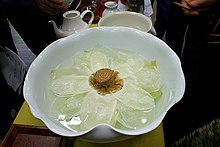Lotus tea
| Lotus tea | |
|---|---|
 | |
| Type | Herbal tea |
| Other names |
|
| Origin | Asia |
| Quick description | Tea made from lotus leaves, flowers, roots, seeds, or fruit |
| Temperature | Varies |
| Time | Varies |
Lotus tea is an infusion made from lotus leaves, flowers, roots, fruit, seeds, or embryos. It is known as liánchá (莲茶, 蓮茶, [ljɛ̌n.ʈʂʰǎ]) in Chinese and yeoncha (연차, 蓮茶, [jʌn.tɕʰa]) in Korean. It is also known as trà sen in Vietnamese.
Lotus leaf tea
[edit]Lotus leaf tea, called yeonnip-cha (연잎차 [jʌn.nip̚.tɕʰa]) in Korean, is a tea made from young leaves of lotus.[1] Leaves for lotus tea are often heat-treated (either by steaming or roasting) before being dried.[1] Sometimes, fresh leaves are also infused as tea. 6–12 g (0.21–0.42 oz) of dried leaves or 15–20 g (0.53–0.71 oz) or fresh leaves are simmered in 600 ml (21 imp fl oz; 20 US fl oz) of water over low heat to produce two to three cups tea.[2]
-
Slicing lotus leaves
-
Roasting lotus leaves
-
Steamed lotus leaves
-
Drying steamed lotus leaves
-
Dried steamed lotus leaves
-
A tea bag of lotus leaf tea
-
Lotus leaf tea
Lotus flower tea
[edit]Lotus flower tea, called yeonkkot-cha (연꽃차, [jʌn.k͈ot̚.tɕʰa]) or yeonhwa-cha (연화차, 蓮花茶, [jʌn.ɦwa.tɕʰa]) in Korean, is a tea made from lotus flower.[3] Often, a fresh whole flower is used to make tea. In Korean temple cuisine, this type of lotus flower tea symbolizes the blossoming of Buddhist enlightenment.[4] Otherwise, 4–8 g (0.14–0.28 oz) of dried petals can be simmered in 600 ml (21 imp fl oz; 20 US fl oz) of water over low heat to make two to three cups or of tea.[2]
-
Making lotus flower tea
-
Lotus flower opening
-
Lotus flower tea (fully opened)
Lotus fruit tea
[edit]Lotus fruit tea, called yeonbang-cha (연방차, 蓮房茶, [jʌn.baŋ.tɕʰa]) in Korean, is a tea made by infusing dried lotus fruits.[3]
Lotus seed tea
[edit]Lotus seed tea, called yeonbap-cha (연밥차, [jʌn.bap̚.tɕʰa]), yeonssi-cha (연씨차, [jʌn.s͈i.tɕʰa]), or yeonja-cha (연자차, 蓮子茶, [jʌn.dʑa.tɕʰa]) in Korean, is a tea made by infusing lotus seeds, which are steamed and dried.[2] For two to three cups of tea, 5–10 g (0.18–0.35 oz) of lotus seeds are simmered in 600 ml (21 imp fl oz; 20 US fl oz) water over low heat.[2]
Lotus embryo tea
[edit]Lotus embryo tea, called liánxīn-chá (莲芯茶, 蓮芯茶, [ljɛ̌n.ɕín.ʈʂʰǎ]) or liánzixīn-chá (莲子芯茶, 蓮子芯茶, [ljɛ̌n.tsi.ɕín.ʈʂʰǎ]) in Chinese and trà tim sen (Northern: [tɕâː.tīm.sɛ̄n], Southern: [ʈâː.tīm.ʂɛ̄ŋ]) in Vietnamese, is an infusion made from lotus embryos.[5]
Lotus root tea
[edit]Lotus root tea, called yeongeun-cha (연근차, 蓮根茶, [jʌn.ɡɯn.tɕʰa]) in Korean, is a tea made by infusing dried lotus root (rhizome) slices or mixing lotus root powder in hot water.[6] Lotus root powder for tea can be made by either by drying lotus root juice, or grinding dried lotus root slices into powder.[2]
-
Dried lotus root slices
-
Infusing dried lotus root slices
-
Lotus root tea
References
[edit]- ^ a b Jeong, Dong-hyo; Yun, Baek-hyeon; Yi, Yeong-hui, eds. (2012). "Yeonnip-cha". Cha saenghwal munhwa daejeon (in Korean). Seoul, Korea: Hongikjae. ISBN 978-89-714-3351-5. Retrieved 28 February 2018 – via Naver.
- ^ a b c d e Jeong, Dong-hyo; Yun, Baek-hyeon; Yi, Yeong-hui, eds. (2012). "Yeoncha". Cha saenghwal munhwa daejeon (in Korean). Seoul, Korea: Hongikjae. ISBN 978-89-714-3351-5. Retrieved 28 February 2018 – via Naver.
- ^ a b Park, Jin-hai (29 October 2013). "Serving lotus, from flower to seed". The Korea Times. Retrieved 28 February 2018.
- ^ Gordinier, Jeff (16 October 2015). "Jeong Kwan, the Philosopher Chef". The New York Times. Retrieved 28 February 2018.
- ^ Song, Lê (5 January 2014). "Những loại trà có ích cho bệnh nhân tiểu đường". VnExpress (in Vietnamese). Retrieved 28 February 2018.
- ^ "9 Nutritious Lotus Root Recipes To Try". Honest Food Talks. 15 January 2021.













